Snow goose hunting has to be one of the most psychotic outdoor activities on the planet. Why? Well, if you’ve never been on a week-long snow goose hunting trip, it has to be one of the most tiring vacations you’ll ever experience. I mean, to do this week in and out requires a special type of person, and there are very few that can stand up and claim to know…the grind.
What is the grind??? Well, it usually starts WAY TOO EARLY in the morning, and after setting and picking up decoys, cleaning birds, scouting, etc. it ends with a repeat the following day. With that being said it’s often called a young man’s game, and for good reason.
I’ve been snow goose hunting for over 30 years and over that time, I’ve accumulated a few things that I felt I could pass onto other hunters. I’m going to share scouting tips, decoys, concealment, cleaning birds and everything in-between. And I will get into the fall and spring seasons separately, as I feel they’re each a different animal. I hope you enjoy it…
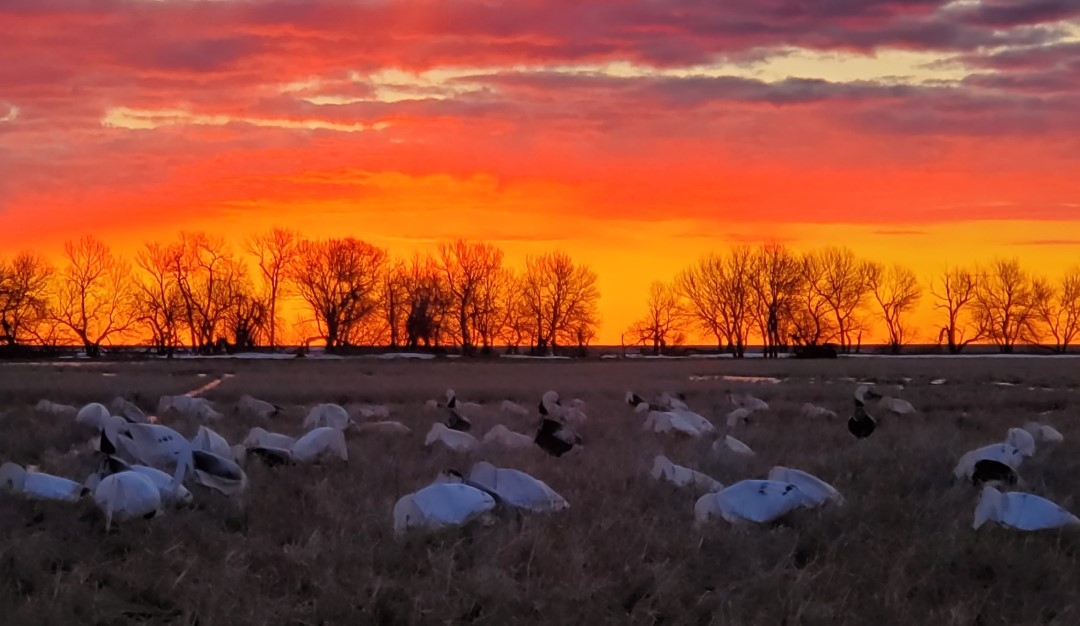
FALL SNOW GOOSE HUNTING
Fall hunting for snow geese, which historically was the O.G. of the seasons, is where hunting can be usually the best. As birds make their way down from the tundra, they’re vulnerable to their first signs of pressure in their staging areas.
I had a waterfowl biologist once tell me that it’s in these staging areas where the adults abandon their young. If you hunt the staging areas of Canada or the Dakotas in the fall, you know what I’m talking about. On a good snow goose hatch year, you’ll have countless juvies bombarding your decoy spread throughout decoy season.
And if you’re in the right place, at the right time, you can witness roosts in the 7-figures in terms of staging numbers. I can honestly say I’ve only seen this maybe a dozen times in my life, but when you do, it’s a sight to behold. Imagine a 4-hour constant flight of birds coming at you…it’s incredible.
So with that being said, here is how I approach hunting snow geese in the fall.
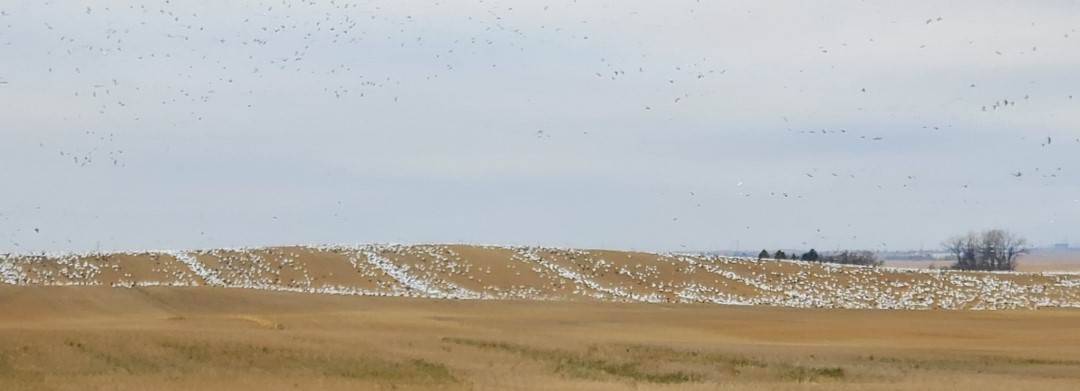
Scouting Snow Geese
Before you put gas in your truck to scout, you should understand a few simple concepts of how snow geese feed and live. Snow geese usually feed twice a day (morning and evening), and roost at night and in-between feeding. However, this isn’t always the case. For example, in the fall snow geese will often feed all day as they build up reserves for the migration. This is actually quite common in my home state of North Dakota in November.
Snow geese usually migrate when the weather is favorable, such as North or Northwest winds. I have seen them migrate into the wind, especially when they get caught in the weather, but more often than not they will ride the wind during a migration.
Typically, when snow geese find a field to feed in, they will start in the middle and sort of “spiral” around the field to the edges. They usually feed out the middle first, then work along the edges until they move onto the next field.
Why is this important? Well, I feel snow geese have a strong memory of where they’ve fed when they hit an area. With that being said, you don’t want to end up in a fed-out field.
So when scouting, if you see geese feeding along the edges of a field, it usually means it’s almost fed out. You’ll probably want to avoid that field and see where they’re moving into next instead.
Lastly, you should always pay attention to what the geese are feeding in, crop-wise. For example, here in the Dakotas, when it’s cold in the fall or the spring, they almost strictly target corn. But when it’s warm (above freezing), snow geese often will feed in small grains instead. Keep an eye on the weather and keep mental notes of what they’re feeding in, and when.

Have ON X Mapping
This almost goes without saying these days for any waterfowler…have On X Hunt Mapping. There’s probably not a more useful app on the market for snow goose hunting. Know where you are and who owns what are the 2 more important aspects of scouting. This app accomplishes both and you can usually get it for around $100/year if you buy around Black Friday (otherwise $16/mo).
I’ve been using On X since its inception and I would feel naked without it. It saves a lot of vital time as the sun is setting during scouting.

Tips for Setting Snow Goose Decoys
This is actually the toughest part to write about. There are so many ways to assemble a snow goose decoy spread that I will try to organize my thoughts.
I will start with what NOT to do when setting decoys.
Snow Goose Decoy Placement
When I was in my 20s, I used to travel for a living. My pilot was my partner in sales, and we flew a Cessna 340. I spent a lot of time looking out the window, especially when we were flying over an area during the migration.
What I learned was that MOST decoy spreads look the same from the sky. How is that you’re wondering? SPACING. Most decoy spreads have decoys that are almost evenly spaced apart. Think about it…most hunters place a decoy, then take a few steps and place another, etc. The end result is a nearly evenly-spaced decoy spread.
Snow geese do not follow the Covid-19 protocol of 6 feet of space. When snow geese are feeding, they’re constantly on the move in search of food. The end result is a smattering of geese.
So with that being said, do not space out your decoys evenly.
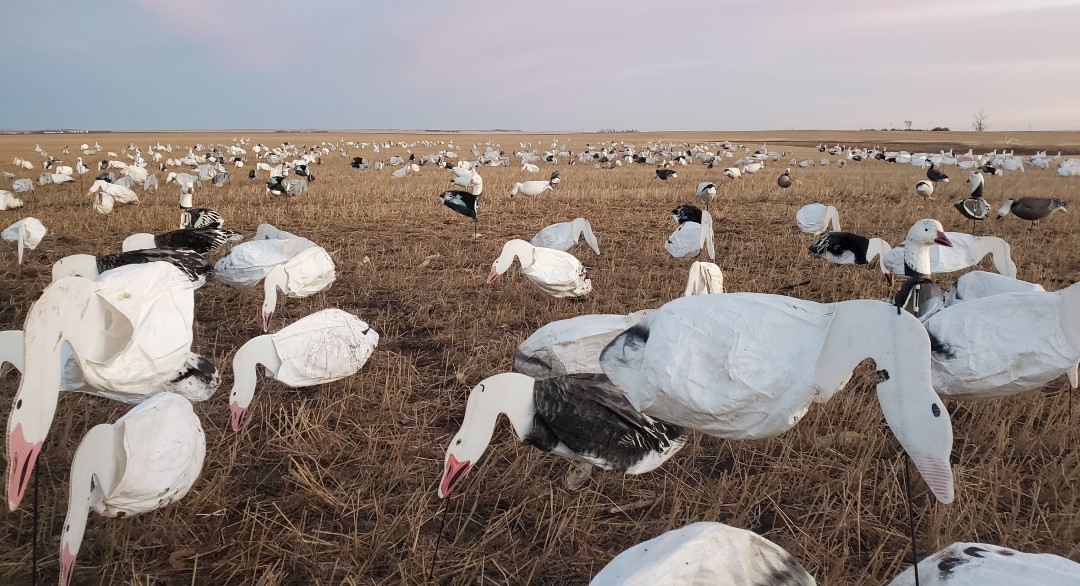
Don’t Set Up Your Spread in Shapes
A lot of guys use shapes and letters as your decoy spread layout…don’t do that. Geese don’t feed in U’s or J’s or whatever. I’ve never seen anything close in nature.
As a general rule of thumb, spread your decoys out as far as you can as possible. Cover as much real estate as you can and make your spread look as big as possible.
Don’t Hunt with LARGE Groups!
This is obviously a personal preference. In my younger days, we were snow goose hunting with 6-8 guys A LOT. It’s awfully hard to hide that many guys well, and quite frankly, I’ve found it to be a bit more dangerous. I’m not a huge fan of guns flying in all directions…should go without saying…
Focus Your Motion Decoys at the Top
Geese will normally key in on the very top of the spread. In nature, that’s where the food is (behind is normally almost fed out). So position your shooters near the top.
With that being said, put most of your motion right behind you or right in front of you (or a combo of both)…at the top of the spread.
However, the higher the wind, the shorter we typically set our spread. In high winds, geese approach the spread LOW, and typically if they bail out it’s at the edge of the decoys. So set up your shooters accordingly.
In high wind, we don’t use rotary machines. The wind is just too hard on them.

Where to Set Up in the Field?
Here are your general rules of thumb for where to set up in a field when snow goose hunting.
First off, what’s the wind that morning? If it’s calm, you’ll want to set up usually in the middle of the field, or on the highpoint or hill in the field. Cover as much real estate as you can with your decoys and it will stick out.
If it’s windy, I usually avoid the hills. Geese like to sit just out of the wind, usually, so I tend to set up in lower areas or backsides of any hills.
Also, stay away from tree rows, power lines, rock piles, sloughs, or anything that would spook the geese on their approach. I’ve had a couple of bangers next to rock piles and sloughs, but usually, I stay away from them. On windy days, however, being in a slough or rockpile just downwind of your spread can be lethal.
Also, when scouting, it’s always a good idea to put the birds you’re hunting to bed. Where did they finish feeding in the field? Often, that’s the easiest way to determine your X. Try to avoid the fed-out sections of the field.
Also, where are they roosting? Your best-case scenario is to have the geese approach the field INTO the wind, not with it.
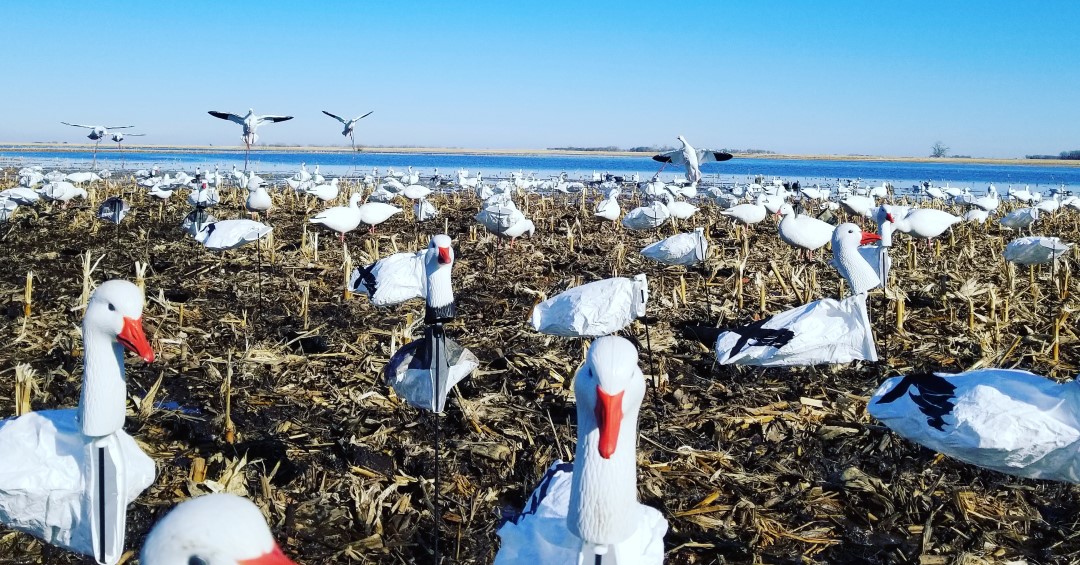
What Snow Goose Decoys Should I Use?
This is really a Ford vs. Chevy debate, honestly. There are a lot of snow goose decoys on the market right now, and MOST will do the trick.
I’m going to make a bold statement. I feel decoys are usually the least important aspect of hunting snow geese. Yup, I said it. I feel guys are so hung up on buying the latest and greatest decoys that they overlook the basics, at times.
I don’t care what you use for snow goose decoys, if you’re in the wrong place at the wrong time, it’s not going to matter. And on the flip side, when you’re on the X where the geese want to be, sometimes the KISS principle applies.
So the real debate of snow goose decoys is full-bodies vs. windsocks. I know a lot of both styles of hunters, and they both go that route for a variety of reasons. And I didn’t include silhouettes for a reason, as I just don’t ever use them. Snow geese like to hover over your spread, looking straight down, and I don’t feel silhouette snow goose decoys do justice in this situation. So with that being said, I will explain why to use both.

Why Windsocks Snow Goose Decoys?
I’m a windsock guy myself. I feel more often than not, decoys are a numbers game for snow geese. And there’s no better way to acquire a BIG snow goose decoy spread than to add windsocks.
If you haven’t looked at the snow goose windsock market lately, I will break the news…it’s flooded. There are a ton of decoys that change every year and I quite simply can’t keep up. I will say, I use an assortment of Sillosocks, Dive Bomb windsocks, Deadly Decoys, and a few Sky Fly’s. These are 4 brands that are well-known in the snow goose world.
I use Sillosocks as the base, and I use only their feeders. I’m personally a Deadly Decoy brand or SkyFly Decoys when it comes to sentry decoys. All 3 have backbones in them when hunting in no-wind situations, which I feel is important. Any old-school snow goose hunters will remember the original Northwind decoys (that had no backbone). Those spreads looked AWFUL in no wind.
I also use some Dive Bomb headless windsocks to help beef up the numbers. As stated, you can’t go wrong with most windsocks on the market that have backbone support.
The problem with windsocks is high wind days. High wind is hard on windsock decoys for one, and if it’s too windy they will do what’s called the “death thrash”. That’s when the decoy whips back and forth in high wind. It’s simply not realistic.
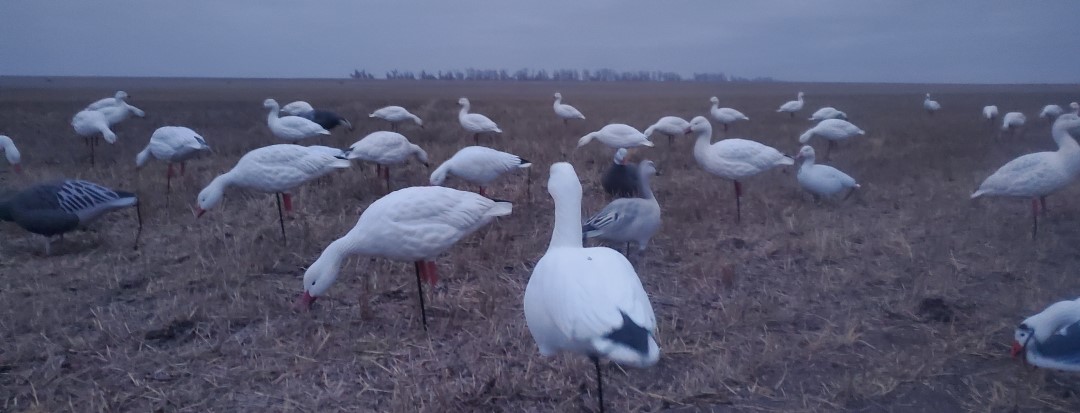
Why Full Body Snow Goose Decoys?
Full bodies are nice to have if you have deep pockets, a BIG trailer, and lots of time to set up. Personally, I never bought into the full-body hype. I’ve simply harvested too many geese over socks to have my mind changed. However, they are nice to have, at times, over windsocks. I will explain when I prefer them.
On really windy days, full bodies shine over windsocks. As stated earlier, socks tend to sway too much making them look unnatural. Full bodies have a lot less movement which is nice in those situations.
Also, if you’re planning to run a permanent spread for a long period of time (say a month or more), then full bodies are the way to go. Windsocks can get beat up badly in high winds and weather, and if you’re hunting in corn, the stalks can shred the bags over time.
And if you can drive into the field, this is the only time I like to put them out myself. If you’ve ever hauled a couple of thousand full-body snow goose decoys into a field with sleds and ATVs, you know what I mean.
When it comes to snow goose decoys, I like as many socks as possible and I will use some full bodies around the landing zone. That’s how I roll, to each their own.
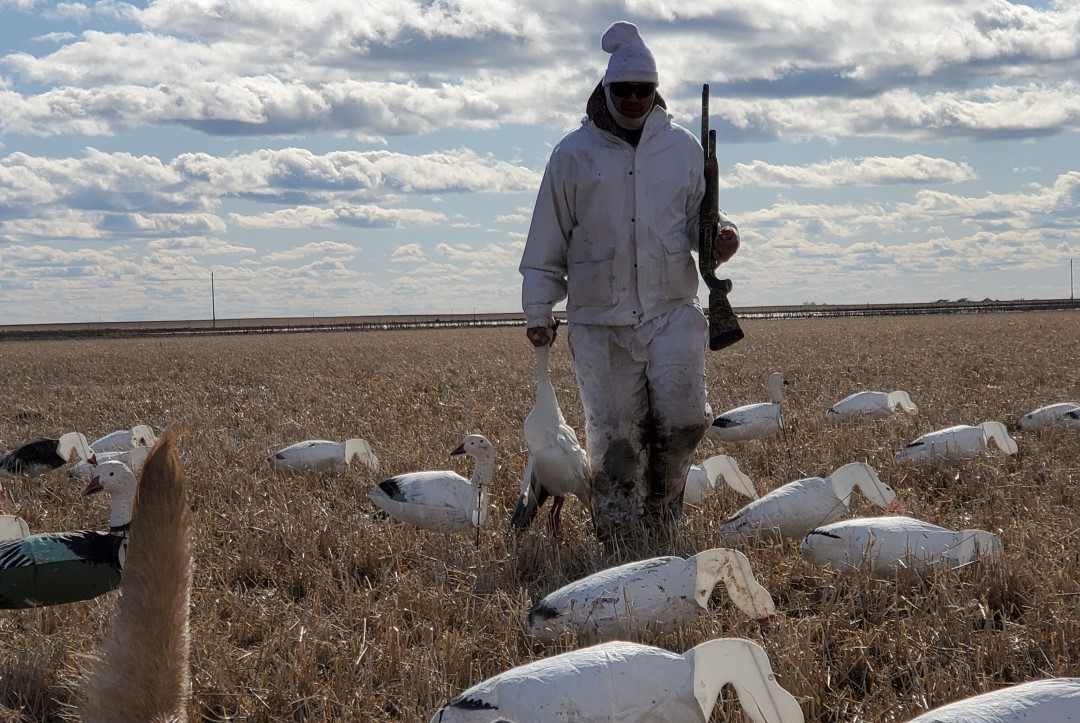
Proper Concealment When Snow Goose Hunting
There are 3 ways that I’m aware of for hiding in the decoy spread; wearing whites, using ground blinds, or an A-frame blind.
- WEARING WHITES – This is the method I use the most for hiding in the decoys in the fall. I use a white coat and white pants myself that are large enough for under-clothing underneath. I also always travel with 4XL Tyvek suits (I purchase in bulk), for those who don’t have whites. They usually only last a hunt or two, but they’re great in a pinch. What I really like about whites is that birds don’t flare often as you pull up. This gives you a high-quality first shot, and a second shot that would be simliar as if you came out of a blind (if that makes sense).
- GROUND BLINDS – I used to use blinds religiously, but I went back to whites over time. Snow geese have just gotten so good at picking them out. Blinds create shadows that are simply impossible to hide. And when those blind doors open, the birds start back peddling rapidly.
There is a way that I’ve found to hide them in most situations. First, you want to set the blinds close together. This will “level it out” and create only one shadow. Next, set windsocks on TALL stakes all around the blind (and in-between the cracks). Finally, take snow goose shell decoys, cut a slit in them, and run velcro through the slits. Basically, you’re creating velcro straps to attach to the stubble straps on the blind doors. We put around 5-6 decoys on each blind. Trust me, the finished product looks solid, but requires some work.
- A-FRAME BLINDS – Okay so I will be honest, I’ve never been an A-frame guy. I know guys who’ve used them successfully, even in the middle of fields, but to me, it just goes against my code of hunting snow geese. It just seems so unnatural to have a mini tree row in the middle of the field, but hey, to each their own. I know someone is reading this right now who slays geese with them…awesome! I simply don’t…
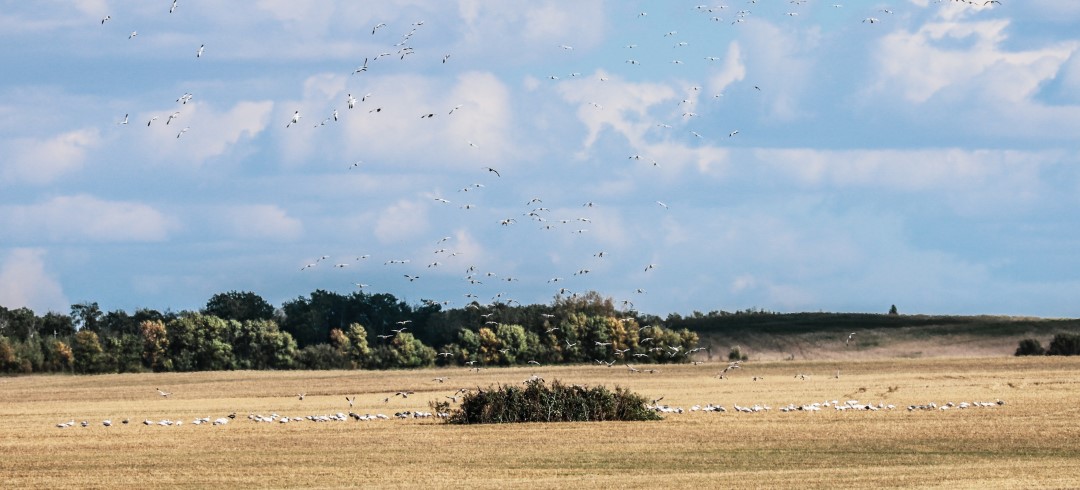
SPRING SNOW GOOSE HUNTING
The first thing you have to understand about spring snow goose hunting, is you have to understand what the birds are doing and why. The goal in the spring is obviously to make their way up to the tundra to breed. With that being said, you have to understand whether you’re hunting geese that are staging and feeding, or migrating. Once you understand what the birds are doing, you can figure out a way to properly decoy them.
There really are 3 types of snow geese coming up in the spring.
The first geese you see are the breeders, the adults, the toughest to decoy. That’s normally the first 3-7 days of the geese arriving in an area.
The next push is a mixture of adults and the start of some juvies. These are the masses. You’ll know when it’s on because you’ll literally see snow geese everywhere when they arrive (assuming you’re in goose country). These are also tough to decoy as you have to usually compete with large neighboring flocks in the distance (always tough to compete with the real thing).
Finally, about 2-3 weeks after the main push comes through, the juvenile snow geese start to arrive. This is when it gets stupid in terms of harvests. This used to be a secret, but that’s long gone. When you find pods of 500 to 5000 snow geese, mostly juveniles, feeding in a field…there’s a good bet you’ll end up shooting a lot of shells on the X.
So with that being said, you need to understand where the migration is at, at all times if you want to decoy geese consistently.

What to Look For When Scouting Snow Geese?
As stated earlier, if you’re hunting staging geese in the spring, you hunt them a lot like the fall. Find the X, and set up there for the next morning.
If you’re hunting migrators, in my opinion, you can’t beat water. To me, this is how I like to hunt snow geese in the spring. Give me a hard bottom, shallow pond that is in the flyway and I’m going to stack that thing with decoys.
I used to hunt A LOT of flooded corn for these situations. Why? Well, you have the corn which is great to imitate feeding geese during peak feeding times, and you have the water spread to cover when they’re thirsty. But it comes at a price…
Hunting flooded corn means MUD and A LOT OF IT. You will usually need an ATV, with Trax, to ensure you’re getting in and out effectively. I’m not going to lie, this is the toughest situation to hunt for these reasons. After a week of hunting in the corn in the spring, my body is TOAST.
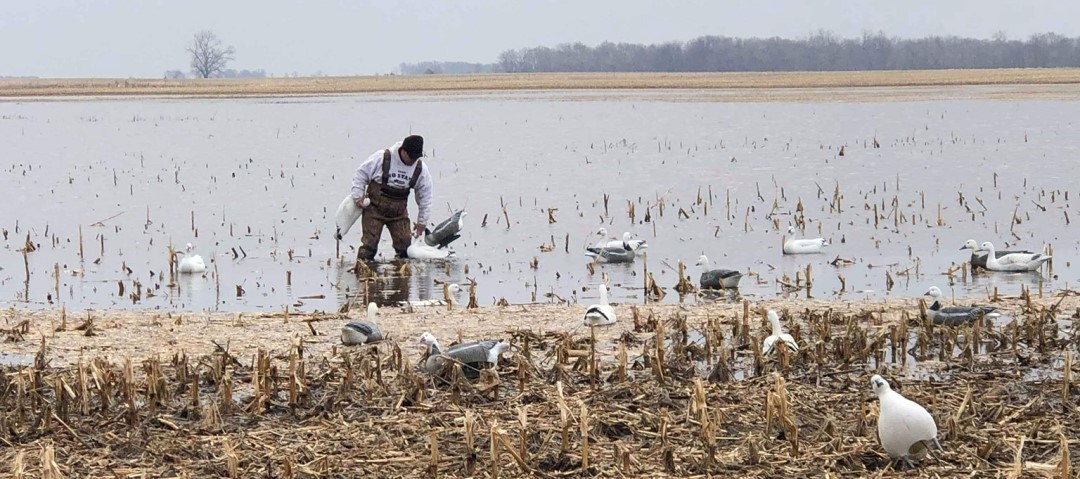
So what do I hunt nowadays? Pasture ponds, mostly, are all I hunt in the spring anymore. The ground is solid so you often can drive a vehicle in, no problem (use proper judgment, of course). Plus, I find pasture ponds to have more of a hard bottom. No sinking on every step like flooded corn (did I mention it’s exhausting?).
So what kind of pasture pond is best? Well, I have a rule of them with any spot where I set up in the spring. I ask myself, “Can I jump that spot if snow geese were there?” If the answer is no, you probably have a winner. Normally, you want a medium-sized pond (maybe around 2-4 acres I like best).
I tend to harvest as many birds in pastures as I did in the corn, so let’s just say I call it a win…

Permanent vs. Run-n-Gun Decoy Spreads
There really are 2 types of spreads in the spring, the run-n-gun and the permanent decoy spreads.
Run-n-Gun Spreads – These are what you need to hunt X’s on the go. This is usually a moderate to large spread, and usually, one that can be deployed in a couple of hours.
This is essentially like hunting in the fall. Find where they’re feeding, and set up there for the morning.
All fall tactics typically still work in the spring, just be where they want to feed.
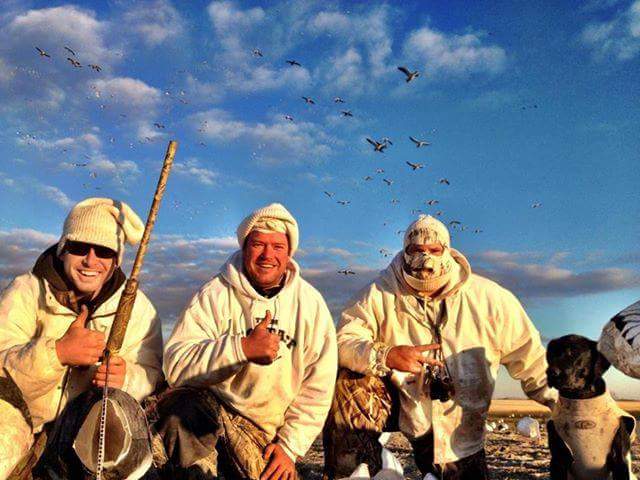
Permanent Spreads – These are spreads that are left out over time during the migration. I like to run these myself when hunting migrators. With these spreads, it’s nice to have as many snow goose floater decoys that you can get away with. Full bodies work great around the shoreline, and socks can be sufficient to bulk it up.
I personally run zero flyers with these types of spreads usually. I feel giving them a natural, resting spread works best for these situations.
The key is to be where the birds want to sit for these types of decoy spreads. Water is the key to hunting migrators, and you don’t want to set up on just any water.
Snow geese are good at roosting in places where they can’t get harassed. And during the spring, most big water is still frozen when the birds are migrating through. So birds will rely on sheet water in the fields or small ponds that are opening.
As mentioned earlier, I like to hunt pasture ponds a lot in the spring.
I’ve had the best luck with a pond that is small enough where I can literally cover the entire shoreline, and scatter floaters in-between. Large, deep ponds are a pain so I just avoid them.
With these spreads, all you have to do is move the blinds/chairs each day based on the wind. No decoy moving is required.

How to Hide Well
As I stated earlier, there are generally 3 ways to hide in or around your decoys (whites, blinds, A-frames).
And I will reiterate that I’m usually a whites guy. If you’re like me, you have 10 dozen snow goose windsocks on TALL stakes. These are perfect for blending you into the decoys.
Snow Goose Decoy Strategies
In my over 30 years of hunting snow geese, I’ve seen PLENTY of gimmicks come and go. Most of them had very little effect, if any, on snow geese (especially with adults).
I won’t waste time talking about those that didn’t work. But there are a few that are worth investing in…

Rotary Machines
One of those inventions was the Rotary Machines for hunting snow geese. The first 2 machines I had were the Cabelas models (the Vortex Machines). I want to say we used them in 2003 or 2004 for the first time…and it was amazing. I recall hunts where we decoyed adults, feet down, consistently in bluebird weather. It was incredible.
I used to say it was like you invented the RoboDuck on snow geese, it was that effective. When Sillosocks came out with their Rotary Machine, it quickly caught on to the masses and it lost its “power” pretty quick.
Over time, the snow geese have caught on to them and they’re not as effective as they once were. We still use a bunch of them often, on really calm days. Otherwise, you have zero movement in your spread. And the juvies and rossies eat them up, so there’s that…
Flyers
Another invention that I feel is worth noting was the Sillosock Flyers. We used them on the rotary machines back then and we still do now. I will say, I rarely use them on fixed stakes anymore. I just feel they see them too much these days, but like rotary machines, they have their place.
Clones
There is a variety of flapping decoys on the market for snow goose hunting. But in my opinion, the Clones outshine the rest. Clones basically mimic a flying goose, and when you use a bunch of them together they can work pretty darn well.
Literally, as I write this, I think about the hunt I had just yesterday where we used a combination of Rotary Machines and Clones, and the juvies ate them up.
However, these are pretty expensive for the average hunter so you have to justify more decoys or these…
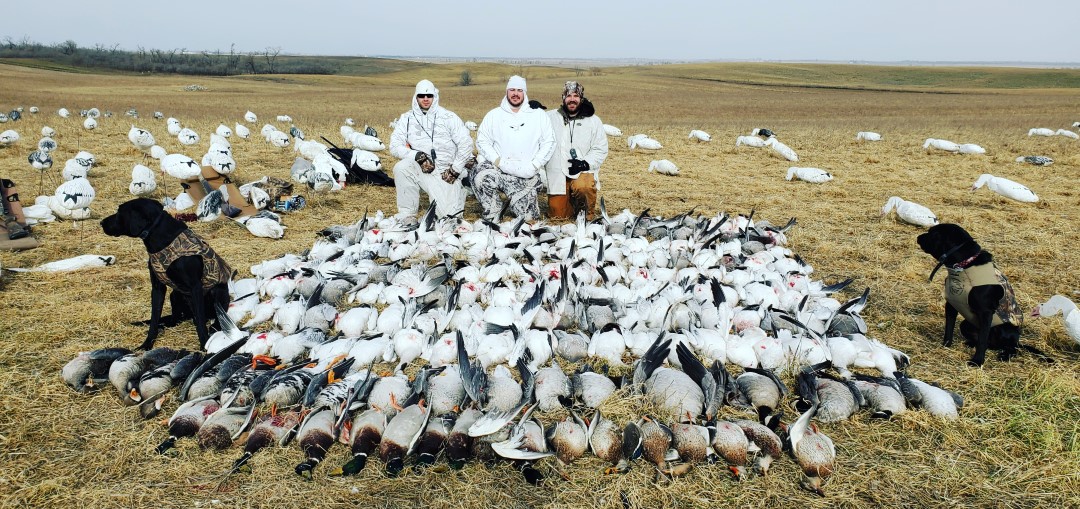
Snow Goose Flags
Another tip for hunting snow geese is flagging. It works, trust me. And if you use a long pole with a flyer on the end, even better. Keeping the motion away from you is the key, and if used properly, it’s killer.
I usually use flags to help draw them towards us, and to provide additional realistic movement in the spread. I also use them when they’re on the sides swinging ways out. I just don’t like to use them when they’re getting close. Just another way to help them pick you out in my opinion.
Snow Goose Calls
Learn how to blow a snow goose call. Seriously. When you get 4-5 guys together that all know how to blow a snow goose call, the results are magic. Snow geese are noisy, and most decoy spreads fail because they’re too quiet.
Now in the spring, you can use electronic callers, so this is a moot point. But in the fall, it helps to know how to blow…
I typically only blow my call at singles, doubles, and small flocks. When larger flocks come, I save my breath. I just don’t think they hear me anyways.
Electronic Calls for Snow Goose Hunting
If you plan to do some snow goose hunting in the spring, then you MUST acquire an e-caller (or more). But you don’t need some massive speaker system, either. I run 3-4 e-callers in my spread, each having 4 speakers. When geese are circling my decoy spread, I don’t want them to run into “dead spots” where there’s no sound. And I usually only run my volume around 30-40% (depending on the unit). Geese don’t typically finish on LOUD speakers, so keep that in mind.
I do know some guys who run just one speaker and have it pointing up in the landing zone. They claim it works just fine. To each their own. FoxPro’s and GooseGetter’s are the E-callers I use.
Tips for Cleaning Geese
There are 2 ways I recommend cleaning snow geese after a hunt. I will show both ways, including keeping a wing on the goose for identification.
- The Nebraska Method of Cleaning Geese
My good friend and fellow waterfowler, J.D. Westerholm from Nebraska, showed me this method years back and I use it often. Rather than try to describe it, simply watch this YouTube video on how we use this method. Google has an age restriction on it, so I can’t share it here (you have to click the link).
- The Bird Hitch
This ingenious product has been around for around a decade or more now, and if you haven’t seen it before, it’s amazing. This device is effective for cleaning large amounts of geese. We take it on all of our snow goose hunting trips (I actually have 2).
Simply rip the goose down the “slide” and it will take out everything but the breasts and both wings. Then we clip a wing and bag it in a cooler. Easy.
See the below video to see it in action.
Best ways to Prepare Snow Geese
Snow geese have a bad rap, historically, when it comes to table fare. They have a bit of gamey taste that turns off a lot of people.
I feel that the problem is with the chef. If you know what you’re doing, snow geese can be AWESOME…just need a few tips.
Don’t Overcook Geese
I NEVER cook my snow geese more than medium…usually, medium-rare is my goal. I feel a lightly seasoned, medium-rare snow goose is delicious on its own. As long as you don’t overcook it, it won’t be tough or extremely gamey…to each their own.
Use the Crockpot
Some of my favorite snow goose recipes are using a crockpot. If I’m hunting multiple days in a row, I will cut my goose into small strips and let it soak in salt water (in the fridge) overnight. In the morning, before we leave to hunt, I will throw the snow goose strips into the crockpot, on low, for 4-6 hours. All you need to add is BBQ sauce, a marinade of choice, or like us Germans…add sauerkraut with the goose strips. The end result is tender strips of delicious goose that go great on a fresh bun.
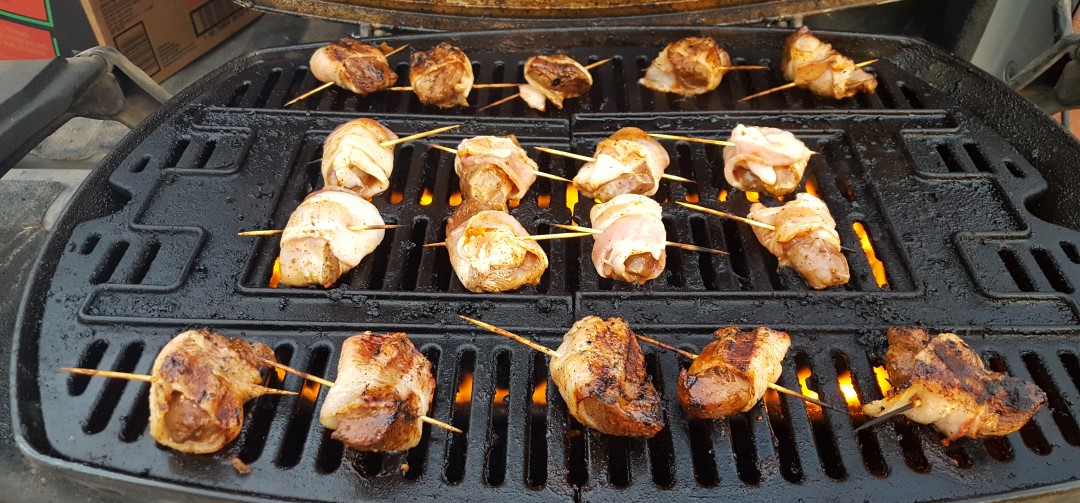
Bacon
Did I catch your attention with bacon??? Try soaking your goose strips in your favorite marinade, and wrap in bacon, and toss on the grill. When the bacon is cooked, your goose is usually medium-rare to medium, at most. Hard to screw up, and who doesn’t like bacon!!!
As a tip, try adding strips of jalapeno peppers, red onion, and a water chestnut along with the goose strip (inside the bacon). Don’t ask me why, it just works…
Best Phone Apps for Goose Hunters
On X Hunt – I already went into detail on this APP, but let’s just say it’s worth every penny.
Windfinder – BY FAR the most reliable APP I know for gauging the wind into the future. It’s not perfect, nothing is, but it’s scary how close it can be most of the time.
Weatherbug – Everyone has their own favorite place to get weather. I use Weatherbug myself. Honestly, anything is more reliable than the Weather Channel…

Best Snow Goose Calls
Redbone Buzzard – Everyone has their personal choice of goose calls, I have mine. In my opinion, there isn’t a better-sounding snow goose call on the market.
If you’re not familiar with Redbone Calls as a snow goose hunter, you’re missing out!
They have 3 different calls that would work well on snow geese, in my opinion. The poly starts at $85 all the way up to the Buzzard at $200. A bit pricey, but totally worth it if you hunt snow geese often. My Buzzard snow goose call has brass guts, which aren’t standard anymore, but you can still get them for a price. This call flat-out screams!
Recap of Hunting Snow Geese
So there you have it, my long-winded article on snow goose hunting. I’ve written a lot on snow geese through the years, but never as in-depth as this one. I also should note, as of recent years, if you hunt with your dog a lot and travel often, you may want to know the latest standards. Many airlines are even dropping dog crates, altogether. Check out dog flying tips at K9.media.
If you have any questions, post up in the comments below and I WILL respond (usually fast unless I’m in the field). I love talking and hunting snow geese.
Good luck and save the tundra!
